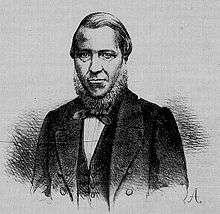Eusébio de Queirós
Eusébio de Queirós Coutinho Matoso da Câmara (Luanda, 1812 - Rio de Janeiro, May 7, 1868) was a Brazilian magistrate and politician, Minister of Justice (1848-1852) and author of one of the most important laws of the Empire of Brazil, the Lei Eusébio de Queirós, which suppressed the slave trade and paved the way for its eventual eradication. He was also responsible for the Commercial Code of 1850 that remains partly in force today.

Early life
He was the son of pt:Eusebio de Queirós Coutinho da Silva and Catarina Matoso de Queirós Câmara.[1] Both His father and grandfather served as superintendent magistrate of Angola. When he was only three years old, his family moved to Rio de Janeiro, where the court of the prince regent of Portugal, future king João VI, was located. After exercising several positions as judge, his father was chosen to be a representative of Angola to the Portuguese Cortes (Constituent Assembly) in 1821, but soon joined the movement for the Independence of Brazil and was a member of the first Supreme Court of Justice of Brazil.
Political career
Eusébio de Queirós graduated with a bachelor's degree in legal and social sciences from the Faculty of Law in Olinda in 1832.[2]:67 He was elected provincial representative as a Conservative for Rio de Janeiro in 1838. In 1842 he was elected to the National Assembly representing Rio de Janeiro, and was re-elected for four more terms.[1]
He was Chief of Police in Rio de Janeiro. He also served as Minister of Justice from 1848 to 1852 under the Marques de Olinda. The position at that time included the command of the National Guard, the Ecclesiastical Affairs (nomination of bishops, payment of priests and bishops) and the appointment of judges and chiefs of police.[2]:28–29
He was the author of one of the most important laws of the empire, the Lei Eusébio de Queirós, promulgated on September 4, 1850, which prohibited the slave trade from Africa to Brazil.[3] Although there had been similar laws before, it was under him as Minister of Justice that the Brazilian government for the first time acted effectively against the slave trade to Brazil (previous laws having been passed mainly to placate the British, who were committed to ending the slave trade internationally).[4] Since he had been Chief of Police in Rio de Janeiro, he knew each of the places where smuggled Africans could be hidden. He also had good connections with the Rio businessmen who trafficked slaves from Africa. Using his information and relationships, he acted with severity in repressing the prohibited traffic, ensuring that it ceased abruptly.[5]
He steered through the law of June 25, 1850 enacting the first Commercial Code of Brazil. This remained in force until 2002 when the new Brazilian Civil Code incorporated Commercial Law. Until today, however, it remains in effect part of the Maritime Law of the Commercial Code of 1850.
He promulgated the Land Law which extinguished traditional land grants and obliged public lands to be acquired by open auction, but also prevented newly arrived immigrants from buying land. He deployed the first law-based penitentiary system in Brazil, dedicating long stretches of his ministerial reports to the subject. He also worked with Irineu Evangelista de Sousa, Viscount of Mauá to install the first gas lighting in Rio de Janeiro.
After serving as a minister, he was a was judge, senator (1854) and member of the Council of State (1855). He was appointed Minister of the Supreme Court of Justice by decree of March 1, 1864. As this position was incompatible with that of State Councilor, he then asked for retirement, which was granted by Pedro II in a decree dated March 21, 1864. In the year of his death he resided in Rua Santa Teresa nº 9, in Rio de Janeiro.
Family life
Eusébio de Queirós Matoso Ribeiro married Dona Raquel Francisca Castro Carneiro da Silva in Quissamã. She was the daughter of his political ally José Carneiro da Silva, the first Baron and first Viscount of Araruama, leader of the Conservative Party in Rio de Janeiro.
His son Manuel de Queirós Matoso Ribeiro also married, in Quissamã, Dona Anna Francisca de Loreto Lima Carneiro da Silva, daughter of Manuel Carneiro da Silva, viscount of Ururaí. His daughter Catarina de Queirós Matoso Ribeiro married, in São Paulo, Rodrigo Augusto da Silva, son of his political ally José Manuel da Silva, Baron of Tietê, leader of the Conservative Party in São Paulo.
Eusébio was great-grandfather of Eusébio de Queirós Matoso Barbosa, a major businessman in the capital of São Paulo; great-great-grandfather of the historian Gilberto de Queirós Matoso, as well as of two mayors of Quissamã, Arnaldo de Queirós Matoso and Armando Cunha Carneiro da Silva.
Legacy
The municipality of Eusébio, Ceará is named after him.[6]
References
- "Eusébio de Queiroz Coutinho Matoso da Câmara". Memória da Administração Pública Brasileira. Arquivo Nacional, Brasil. Retrieved 14 April 2019.
- Jeffrey D. Needell (2006). The Party of Order: The Conservatives, the State, And Slavery in the Brazilian Monarchy, 1831-1871. Stanford University Press. ISBN 978-0-8047-6806-1.
- Luiz Antonio Giraldi (2014-06-05). A Bíblia no Brasil Império: Como um livro proibido durante o Brasil Colônia tornou-se uma das obras mais lidas nos tempos do Império. Sociedade Bíblica do Brasil. p. 1. ISBN 978-85-311-1342-0.
- "'Leis para inglês ver' antecederam abolição da escravatura no Brasil". g1.globo.com. Globo.com. Retrieved 14 April 2019.
- Graden, Dale T. (May 1996). "An Act "Even of Public Security": Slave Resistance, Social Tensions, and the End of the International Slave Trade to Brazil, 1835-1856" (PDF). The Hispanic American Historical Review. Retrieved 14 April 2019.
- "Origem do toponímo: Homenagem ao abolicionista Eusébio de Queiroz Matoso Câmara" (PDF). biblioteca.ibge.gov.br. IBGE. Retrieved 14 April 2019.